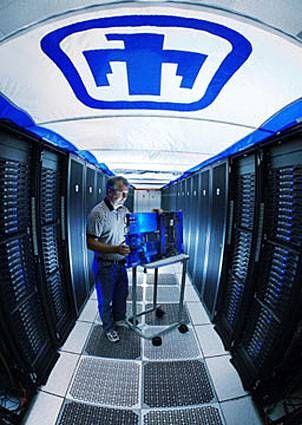Taming the Wild Supercomputer
Ignore Power And Heat
The cost of electricity (power) can eclipse the cost of a supercomputer after only two to four years. The enormous amount of power consumed creates lots of heat. The removal of this heat adds even more cost because of the need for air conditioners, fans, blowers, etc.
The problems of power and heat are interdependent. As system performance needs increase, faster power-hungry processors are used. Problems exist that require performance millions of times greater than today's fastest supercomputers. These factors present an ongoing, never-ending challenge.

Sandia Thunderbird Supercomputer
A great deal of attention has been drawn to the power needed by large clusters of computers. The attention is well founded, as power consumed by typical clusters can easily exceed 60% of the yearly operational budget for hardware. Solutions to power requirements are seated within processor manufacturing technology. Since high performance systems will tend to scale to power constraints, ultimate performance will be limited by expendable power. This is a natural phenomenon, because many applications require the highest performance that can be mustered from a given technology. There is no real, obvious solution if ultimate performance is needed, only better ways to cope, so that greater performance is at least possible. I hope that my supercomputer design copes really well!
The result of power consumed, is the heat generated through inefficient power conversion and use. The removal of this heat requires large air-conditioning and air-movement systems, which consume even more power. This leads to a never ending increase in heat generated and associated cooling requirements. This means that ultimate performance is not only limited by power, but also by the system's ability to draw heat away.
Many processes running on supercomputers don't really require great single-processor performance, but still need fast query response times. Web searches are a good example. These processes can be efficiently addressed using multithreading and large, clustered systems. There can be a scale-oriented balance. For example, the fastest supercomputer in use today is made up of more than 100,000 processors. The performance of a single one of those processors is less than one-half the performance of a typical PC. Scale matters.
So, if you want to keep supercomputers out of the office, make them power-hungry, fire-breathing monsters. After the first year of electrical bills, they will be tossed out of the office and shoved back into a controlled environment. Alternatively, scale the system for more power efficient, slightly slower processors. In the meantime, we can keep encouraging microprocessor manufactures to build less power-hungry, more efficient processors. Thank goodness for notebook computers. Notebooks cannot operate for long without power conservation.
Stay on the Cutting Edge
Join the experts who read Tom's Hardware for the inside track on enthusiast PC tech news — and have for over 25 years. We'll send breaking news and in-depth reviews of CPUs, GPUs, AI, maker hardware and more straight to your inbox.
Current page: Ignore Power And Heat
Prev Page Use Custom Processor Architecture and Interconnects Next Page Make 'em Big, Noisy And Impossible To RelocateMost Popular

